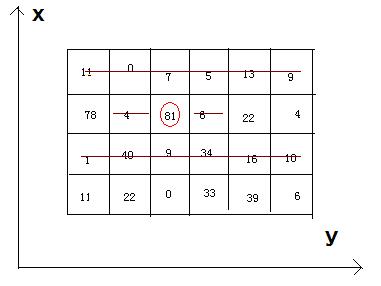Beans
Time Limit: 2000/1000 MS (Java/Others) Memory Limit: 32768/32768 K (Java/Others)
Total Submission(s): 3418 Accepted Submission(s): 1629
Problem Description
Bean-eating is an interesting game, everyone owns an M*N matrix, which is filled with different qualities beans. Meantime, there is only one bean in any 1*1 grid. Now you want to eat the beans and collect the qualities, but everyone must obey by the following rules: if you eat the bean at the coordinate(x, y), you can’t eat the beans anyway at the coordinates listed (if exiting): (x, y-1), (x, y+1), and the both rows whose abscissas are x-1 and x+1.

Now, how much qualities can you eat and then get ?

Now, how much qualities can you eat and then get ?
Input
There are a few cases. In each case, there are two integer M (row number) and N (column number). The next M lines each contain N integers, representing the qualities of the beans. We can make sure that the quality of bean isn't beyond 1000, and 1<=M*N<=200000.
Output
For each case, you just output the MAX qualities you can eat and then get.
Sample Input
4 6
11 0 7 5 13 9
78 4 81 6 22 4
1 40 9 34 16 10
11 22 0 33 39 6
Sample Output
242
解题思路:通过两次动态规划,分别对每行和列进行dp。对于每行状态定义:dp[j]表示该行到达第j列时的最大的和。转移方程:dp[j]=max(dp[j-2]+a[j],dp[j-1])。然后用另外的一个d数组记录每行的最大和,相当于矩阵变成了一个列矩阵。再定义状态dq[i]为表示到达该行时的最大和。转移方程:dq[i]=max(dq[i-2]+d[i],dq[i-1])。
#include<stdio.h>
#include<algorithm>
#include<string.h>
using namespace std;
const int maxn=211000;
int a[maxn];
int dp[maxn],d[maxn],dq[maxn];
int mmax(int a,int b,int c){
int ret;
ret=a>b?a:b;
return ret>c?ret:c;
}
int main(){
int n,m;
while(scanf("%d%d",&n,&m)!=EOF){
int i,j,k;
for(i=1;i<=n;i++){
for(j=1;j<=m;j++){
scanf("%d",&a[j]);
}
dp[0]=0,dp[1]=a[1];
for(j=2;j<=m;j++){
dp[j]=max(dp[j-2]+a[j],dp[j-1]);
}
d[i]=dp[m];
}
dq[1]=d[1];
for(i=2;i<=n;i++){
dq[i]=max(dq[i-1],dq[i-2]+d[i]);
}
printf("%d
",dq[n]);
}
return 0;
}